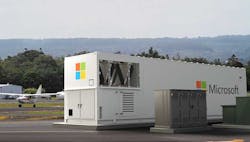Azure Space Connects Microsoft Edge Modules to Satellites (Including SpaceX)
Microsoft has formally launched Azure Space, featuring deeper ties with satellite broadband provider SES, a new partnership with SpaceX’s Starlink satellite broadband service and a new Azure Modular Data Center (MDC). Azure Space combines Microsoft’s cloud computing expertise with satellite broadband connectivity, along with its previously announced Azure Orbital ground station service.
The Azure MDC allows users to place a fully functional edge data center anywhere in the world without the need for fiber, a capability Microsoft says is currently in operation with defense and private sector organizations. The new offering, along with the rollout of AWS Local Zones, further extends the reach of major cloud computing platforms in the edge computing sector.
Tuesday’s announcements reflect Microsoft’s growing ambitions in space, and outlined how it will wield its satellite assets in expanding the reach of its Azure cloud infrastructure.
“By building on new and existing partnerships within the space community, leaning into our culture of innovation and investing in the power of our people we will extend the utility of our Azure edge capabilities with worldwide satellite connectivity, unblock cloud in more scenarios and empower our partners and customers to achieve more,” said Tom Keane, Corporate Vice President, Azure Global.
Building the SES Partnership
Last month’s announcement of Azure Orbital at Microsoft Ignite introduced the company’s satellite ground station service and a formal relationship with satellite broadband provider SES to collocate satellite ground stations with Azure data centers, providing a direct link between the Azure cloud and SES O3b mPower connectivity.
SES’s O3b Medium Earth Orbit (MEO) constellation provides low latency – for satellite – broadband at around 140 milliseconds with speeds up to 10 Gbps, with proven end-user installations around the global. But the company, like other telecom providers, realizes that connectivity is only one part of the equation and it needed to provide more than just a dumb pipe by offering better connectivity to Azure services and the cloud.
“The satellite industry needs to disrupt itself,” said SES CEO John-Paul Hemingway. “We need to disrupt ourselves. We need to embrace more orchestration and automation. We need to embrace more virtualization. We need to be able to have seamless orchestration across cloud, content, and connectivity. And we need an ecosystem to do that within. We can’t do it ourselves. Microsoft is the leader in that ecosystem, which is why we have deepened our partnership with Microsoft for the last 12-18 months.”
A diagram of the components that make up Microsoft Azure Space.
SES’s work with Microsoft is being complemented by the newly announced relationship with SpaceX and its work-in-progress Starlink broadband network. “Starlink brings point-to-point communications from anywhere on Earth, so leveraging that along with Azure is really an incredible robust capability for our customers,” said Gwynne Shotwell, President and COO, SpaceX.
The SpaceX Connection
For Microsoft, SpaceX is another satellite partner with deep ties to the U.S. government through launch and its broadband demonstrations with the military and a part of its approach to “supply a multi-orbit, multi-band, multi-vendor, cloud-enabled capability to bring comprehensive satellite connectivity solutions to meet the needs of our customers,” according to a Microsoft blog post.
Details on SpaceX Starlink trials have started to emerge as the company plans to move into an open public beta phase by the end of the year in the Northern United States and potentially Canada if regulatory approval is worked out. Initial data rates of over 100 Mbps and latencies of under 20 milliseconds have been reported by testers and to the FCC by SpaceX. With over 700 Block v1.0 satellites in orbit, the company is half way to completing its first-generation constellation of over 1,400 satellites for global service and is launching batches of around 60 satellites at a pace of one to two flights per month.
Worldwide broadband satellite connectivity means customers can reach Azure from anywhere on the planet, but it also means Microsoft can put a data center nearly anywhere on the planet. The Microsoft Azure Modular Datacenter is the final piece for an off-the-shelf capability to deploy cloud computing in what Azure General Manager for Global Industry Sovereign Solutions Bill Karagounis describes as “hybrid or challenging environments.”
The Azure MDC Extends the Edge
The Microsoft Azure MDC is designed for use cases requiring high-density secure computing, including mobile command centers, humanitarian assistance, military mission needs, and mineral exploration. Microsoft says the MDC gives customers a path to migrate apps to Azure while still running workloads on premises with low-latency connections to their own data centers, providing options to move workloads to the Azure API while continuing to run apps on-prem, or in public or sovereign clouds.
Microsoft has a long history of deploying modular data centers, including the factory-built IT PAC (Pre-Assembled Component) modular units that were the core building block in the company’s data center infrastructure for several years. More recently, Microsot has deployed an underwater data center that operated for two years on the ocean floor, putting 864 servers in 12 racks and dropping them off the coast of Scotland.
The Azure MDC’s features include a self-contained datacenter unit about the size of a standard shipping container that is field transportable, able to operate in a wide range of climates and harsh conditions in “ruggedized” RF shielded unit. It also includes a network high-availability module that continuously evaluates network performance so it can move traffic between a primary network and a backup satellite connection or use satellite is the primary connection when nothing else is available.
The ability to deploy Azure MDCs in areas beyond existing fiber routes offers a new capability, extending edge computing use cases where infrastructure may be missing or damaged. It also offers Microsoft a rapid deployment option for organizations seeking to expand their edge infrastructure.
About the Author



